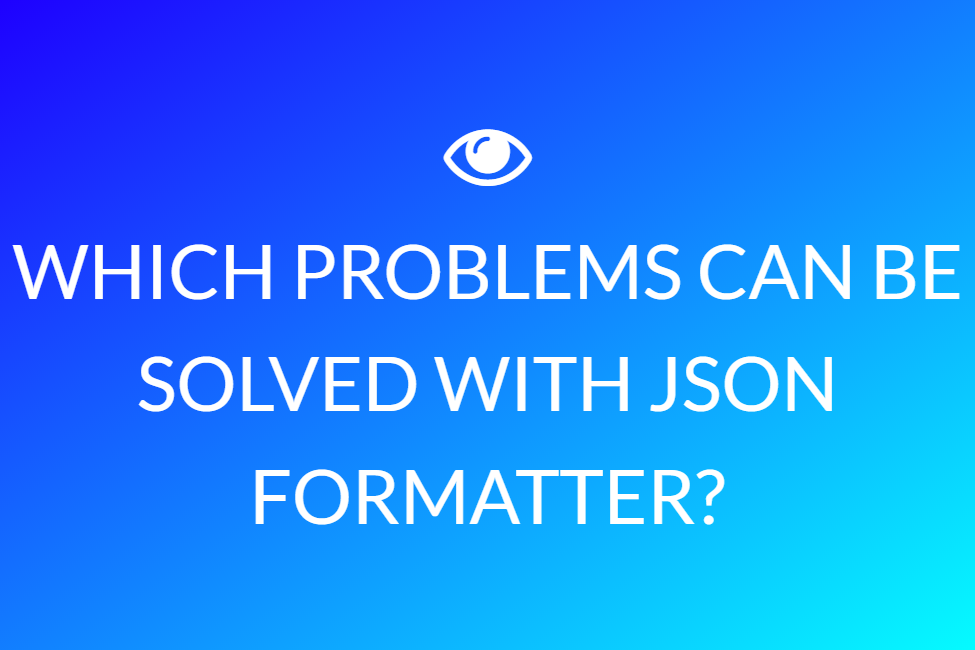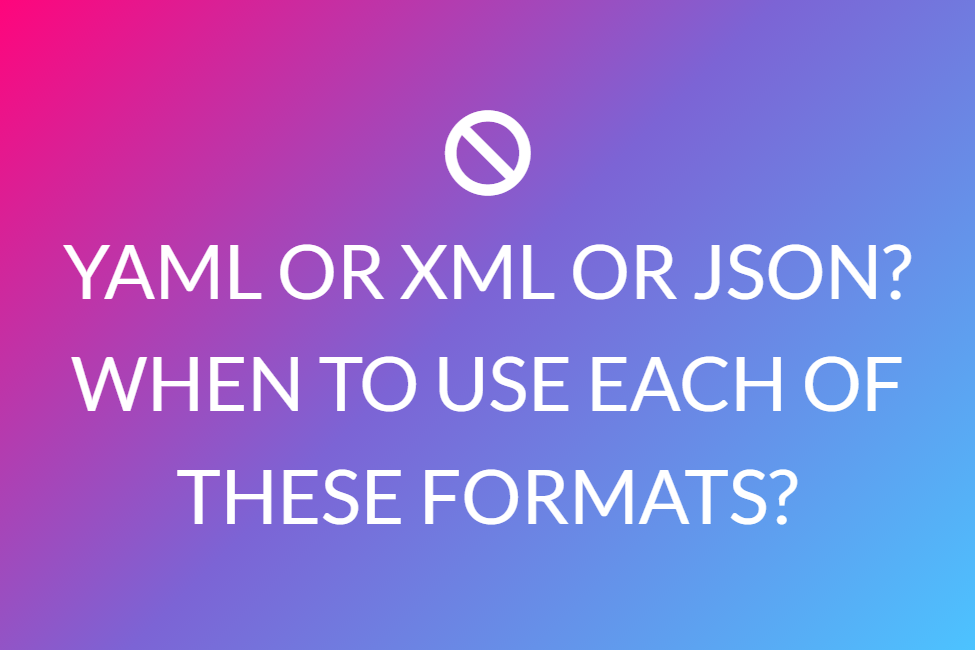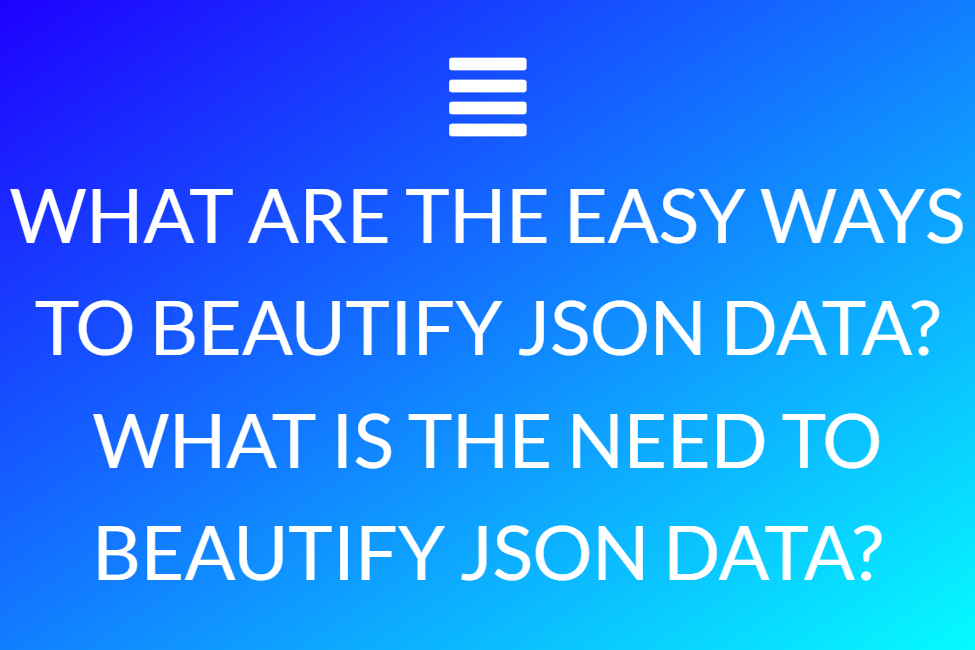In this article, one will understand what JSON is and how they can deal with errors transpiring when parsing JSON, such as Unexpected Token in JSON.
What Is JSON?
JSON, the term basically an acronym of JavaScript Object Notation, and these are some of the most widespread data formats utilized for transferring data. It is a lightweight structure and has the name-value pairs.
There are six kinds of data sorts in JSON-
- String
- Number
- Array
- Boolean
- Null
- Object
In the ancient days, XML was mainly used for interchanging data, while since JSON occurred, it is often used as a substitute for XML. A JSON file must end with the extension of .json. The JSON format is fairly similar to JavaScript things, but it is not constantly the case. It is important to recognize that every belongings name must be shrouded in double quotes. . It employs JavaScript syntax and the data can be easily read and operated by any programming language.
What is JSON utilized for?
JSON is used for contact between server-side technologies and smartphone apps or even the website.
What is the law for writing JSON?
JSON is the group of key and value pairs divided by the comma.
Key values are diverged by the colon (:).
Square frames are used to reserve JSON arrays.
Curly brackets are used to hold JSON entities.
JSON vs. XML?
- XML needs an XML parser in order to parse it. JSON is, on the other hand, parsed with the support of JavaScript functions.
- XML is weighty and lengthy. JSON is short and light.
- XML is a document-type. JSON is data-type.
- JSON is easy to read, write and comprehend. XML is less easy to read, write and comprehend.
Is My JSON Formatted Perfectly?
Projects sometimes need a configuration that is transmitted to the customer from a server. Just so one knows, keeping the config particulars as a JSON will be faster than using an object literal, as engines need to do more steps when running an object literal than JSON.parse (), for example.
If one has a file with the data of JSON, one of the foremost things to do is to guarantee that the data is being formatted accurately. There are several sites that can assist one with that. These formatters tools not only will review if the JSON is formatted precisely, though they can also correct some of the blunders, beautify it, or assemble it to make it more compact.
Why does one get errors trying to read JSON data?
JSON is an incredibly popular format and is typically used for data interchanging. We have spoken about what JSON is including the things we can do with it. For starters, be sure to double-check in case the values one is negotiating with are what they expect them to stand, and retain, console.log() can be the companion.
What are the common errors in JSON?
1. NULL or inaccurate data errors.
Solution
Inspect the following common problems and rectify or cross-check if one is using the valid JSON SerDe.
2. Use the right data type per column
The second line in the ensuing example contains the wrong data type for “age”. The column should have the value of “12” instead of “twelve”.
3. Use the right extension for JSON files
When one is using a compressed JSON file, then it must end with “.json” pursued by the extension of the format, for say “.gz”.
4. Be certain that every row in the JSON table must be there in JSON format
1. Make a table with a delimiter that’s not there in the input files.
2. Run a query equivalent to the return name of the file, row points, and the file path for the null JSON rows.
Now, what is parse, validator and reformatter tools
For the meaning of downstream restoration, there are different JSON Parse tools available that have the primary function of extracting JavaScript Object Notation readers into a table. By providing the execution into the JSON tool, it can be backed up into a working File format.
What are JSON parse tools employed for?
The JSON. parse () method parses a JSON, constructing the JavaScript value or item described by the string. An optional stimulant process can be provided to perform a transformation on the resultant thing before it is delivered back.
Pros
It comes with tons of different tools like coding beautifiers, and JSON converters, etc.
2. The JSON reformatter tools
We also have JSON reformatter free tools available that have been created to support people with debugging. As JSON details are often output without line interludes to save space, it can be incredibly difficult to even read and make sense of it. These tools are expected to solve the issue by formatting and thus even more beautifying the JSON data. Thus, it becomes manageable to read and debug by people using it.
JSON formatter tools have the following features
- It lets one validate if a JSON is valid or not and delivers error messages.
- It lets one beautify a compact JSON for easier reading.
- JSON reformatter helps to structure and EVEN test JSON data. It delivers a tree idea that allows one to explore the gathered JSON data. It also presents JSON to CSV, JSON editor, JSON to XML, JSON cleaner, and JSON checker conversion means.
JSON Validator tools
JSON Formatter and Validator are online tools that have been designed to format and embellish JSON to create it more comfortable to read and debug. Developers utilizing the online formatter tools can simply paste in JSON or a URL. The JSON Formatter and Validator tools can be utilized to format and validate a general JSON URL.
Best JSON Tools Available online To Parse, Format, Validate and More
1. JSON Parser Online
Out of diverse JSON tools, JSON Parser online can be the easiest, to begin with. It offers different functionalities like visualizing, editing, embellishing, and decoding the JSON code. It even parses the JSON string into a multi-coloured tree or JSON map picture. This parser transforms the JSON string into a legible human string, easy to read by humans.
This JSON tool even specializes in string manipulation plus, creates Fake APIs that can be useful for the testers and designers while their task of prototyping. JSON parser online has additional utilities even for creating and experimenting with the JSON strings. The JSON Parser provides the element to parse JSON into string parse and JS eval. It also supplies the view to embellish, show sorts, and indexes of a JSON thing. One can also send the data of JSON to the parser by presenting an HTML form.
One of the best specialities about this means is that it presents a plugin that can be utilized for most of the editors.
2. JSONFormatter.org
JSON Formatter and Validator is, however, another tool that is designed to parse and pretty the JSON codes. This makes it easier to read by humans and debug the JSON files. The online tool supplies a tree view that allows navigating to the formatted JSON. Nowadays, this online JSON editor creates the script easier and legible by human beings.
3. JSONFormatter.io
JSONFormatter is yet another available online free tool and is a versatile JSON editor used to parse, validate, format, view and edit the data of JSON in true -time. One of the most effortless to use, the JSON Formatter editor device gives a born editing experience. Like the easy online editor tool, copy, or paste the JSON data into the intake box and just click on the Validate option. Here, one will get validated, parsed and decorated JSON in the editor box.
Seven best Ways to Enhance JSON Performance and their Usage with the online available tools
JSON is effortless to work with and has evolved the standard data structure for almost everything. Although initially emanated from the JavaScript scripting language, this is now a language-free data format and principles for parsing and generating JSON data are readily obtainable in many programming terminologies.
1. Use streams if possible
Many of the JSON parsing libraries can read directly from a stream rather than a string. This is slightly more efficient and best where possible.
2. Compress the JSON data
Since JSON is only simple text, one can expect to earn up to 90% compression. Therefore, use gzip if possible when transmitting with the web services.
3. Bypass parsing JSON if one doesn’t require to
This may appear obvious, but this necessarily isn’t. For web applications that receive JSON and just write it to a line, database, or additional storage, attempt not to parse it ever to that JSON if one can. When utilizing something like ASP.NET Web API, don’t restrict the methods predicting specific classes for incoming from the data and rather read the body of the post so ASP.NET never parses with this JSON.
4. Serialize or Deserialize More extensive vs. Smaller JSON Entities
In some usage cases, one may receive a big object array that they have to split up into smaller parts. For instance, at some use as part of their error & log control tool, they can obtain some large JSON notifications of log statements. They queue the log statements as they arrive and there is a full message size of the line. In the first rendition of the code, they were looping via the array and held serializing one log message at a moment because the last output could just be up to a specific size to queue. They were able to accomplish some optimization for this reason and it made a rather significant distinction in server CPU use.
5. Don’t preprocess each of the fields, null or default values
Inspect the settings of the library of JSON in order to see how one can disregard precise fields, omit null values, etc. Many .NET libraries shall use DataContract or DataMember attributes and settings.
6. Use more brief field names
Most libraries allow one to specify details of their classes to override the terms of the fields because they are being serialized. It can let one make their field names much slighter when serialized while more human-readable in the code. Using shorter field names can provide a 5-10% parsing execution boost plus of course slightly fewer data packets being decreed around.
7. Have you considered alternatives to JSON?
JSON isn’t the answer for everything. XML has run out of favour since JSON has evolved to be the standard, but relying on the use case, it might even be a suitable fit for anyone. Especially if someone wants to enforce a healthy schema. Another opportunity can be with BSON or even the MessagePack, which are kinds of binary-based object serialization. The sole big downfall is that they can’t be human-readable and editable just like JSON.
Why JSON TOOLS?
The extensible markup language (XML) was utilized to be the best option for open information exchange. Nevertheless, expansion in the open data share-out presented more opportunities for designers. Javascript is just one and the reasonably possible alternatives nowadays. The first thing that arrives in a designer’s thinking when someone remarks about JSON is that it is lightweight compared to other known data interchange options. However, that’s not the only reason to use it for API inclusion.
following celebrate more features-
1. They are Faster - JSON syntax is extremely easy to use. We have to operate only as a syntax that delivers us a comfortable parsing of the JSON DATA and more rapid execution.
2. Server Parsing - the server parsing is the essential part that designers want as if the parsing tool shall be fast on the web server then one can get the fast reaction of their answer.
3. Schema Support - It has a broad range of supported web browser compatibility with the working systems.
4. Best and free Tools are available for sharing JSON data – This is due to the fact that JSON can store n number of data in the arrays to make the transfer becomes easier.





